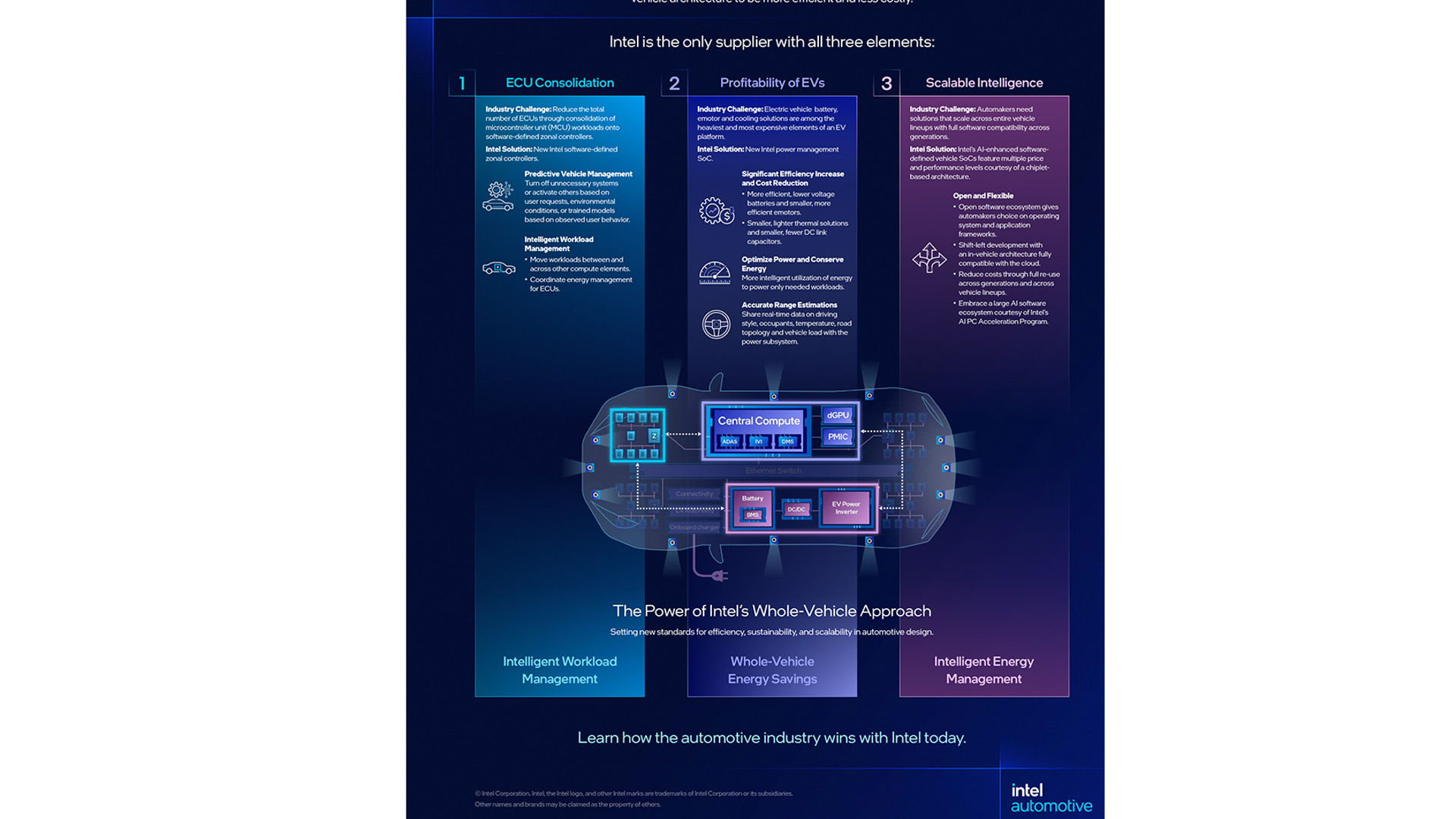The automotive sector is experiencing a significant transformation in almost every aspect – from business strategies and supply chains to innovative in-car interactions, such as artificial intelligence. Unfortunately, these changes are often accompanied by increased expenses for automakers, particularly due to the high costs associated with advanced AI-enabled system-on-chips (SoCs) and the ever-growing and costly batteries for electric vehicles (EVs).
To address this cost challenge and stay profitable while delivering the desired next-gen experiences, the industry needs to find solutions amidst the continual progress in technology.
The solution lies in embracing a holistic approach at a system level.
Embracing a Comprehensive Strategy
Mitigating various cost challenges cannot be effectively achieved by focusing on individual components alone. Instead, Intel recommends a comprehensive, system-wide strategy.
Instead of just enhancing individual components (which we indeed do), we establish connections to bring about benefits throughout the system. Our focus is on integrating three crucial elements: software tailored for in-car computing, intelligent management of energy, and workload management akin to data center operations. The synergy from these advancements offers a synergistic effect beyond simply striving to optimize the cost of any single aspect of the vehicle.
The Intel method views vehicle systems as an interconnected “whole,” enabling seamless migration of workloads between centrally defined software systems for computing and zonally defined subsystems for computing, guaranteeing optimal cost and performance with considerable energy efficiency gains.
Breaking the Barriers
Current vehicle architectures are siloed, leading to inefficiencies. For instance, many EVs support a feature that continuously monitors external cameras for security threats or driver recognition even when the vehicle is inactive. This feature is primarily supported on the vehicle’s internal computing subsystem, which, due to its high power usage, unnecessarily drains the battery when the vehicle is not in operation.
This processing workload doesn’t need to remain on the central compute system. By utilizing Intel’s zonal controllers for managing camera streams, we can adopt data center application organization principles, transferring the workload to a lower-power device (in this instance, the zonal controller) and only waking the central compute system when necessary. This approach conserves energy, enhances efficiency, and reduces the overall number of electronic control units (ECUs) in the vehicle by dynamically consolidating workloads onto a zonal controller regulated by software.
Furthermore, integrating smart power strategies with control systems can significantly reduce energy consumption across the vehicle. For example, deactivating the ADAS ECU while the vehicle is recharging or adjusting power usage based on environmental conditions can lead to substantial energy savings. When in Detroit during winter, deactivate the A/C ECU. In Phoenix during summer, disable the seat warmer and windshield wiper ECU.
While these are straightforward examples, they embody a significant transformation achievable through a system-wide perspective on a vehicle’s architecture.
Extending this concept across the entire vehicle with each ECU managed by a centralized power management controller opens up limitless opportunities for conserving energy. This would enhance the efficiency of every vehicle, whether it’s powered by an internal combustion engine (ICE) or an electric powertrain.
These strategies are not groundbreaking. They have revolutionized the PC industry, resulting in longer battery life through standards like the advanced configuration and power interface (ACPI) specification, allowing for the identification and deterministic control of all power-consuming devices on a PC platform. This transformation is largely responsible for the evolution of early laptops with minimal battery life to the all-day battery life enjoyed today. This same approach is now being applied to the automotive sector with the introduction of the new SAE Vehicle Platform Power Management Standard (J3311), which aims to apply these proven PC concepts to vehicles.
An Inclusive Architectural Philosophy Rooted in Data Centers
An appropriately executed software-defined design is a fundamental mindset in architecture – a philosophy that views compute, memory, and I/O as shared resources that can be dynamically allocated without interference to cater to any workload. Adopting such an approach revolutionizes the way we perceive a vehicle’s electrical/electronic (E/E) architecture, moving away from fixed-function sockets with a direct application-to-silicon mapping to a resource pool spanning multiple sockets, enabling fresh system-wide approaches to deliver the experiences demanded by consumers.
In essence, it mirrors a data center approach rather than a smartphone/tablet methodology. Intel has successfully implemented this approach numerous times, positioning the company ideally to guide the automotive industry through this significant transformation.
The Transition Process is Underway
The shift towards software-defined, sustainable, and scalable vehicles is challenging. However, the journey becomes more manageable by moving away from evolving vehicle architecture one component at a time.
Adopting a holistic system-level outlook, coupled with appropriately designed silicon and features, will pave the way for new avenues to achieve profitability, a path where Intel holds a exceptional position to lead.
Jack Weast, an Intel Fellow, serves as the vice president and general manager of Intel Automotive at Intel Corporation.
SOURCE: Intel
[ad_2]

